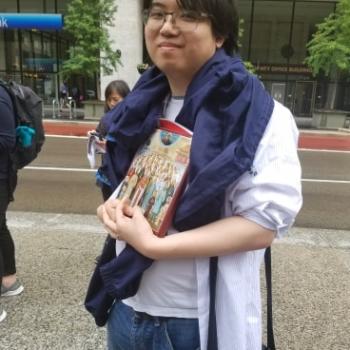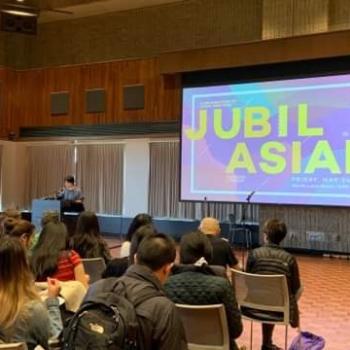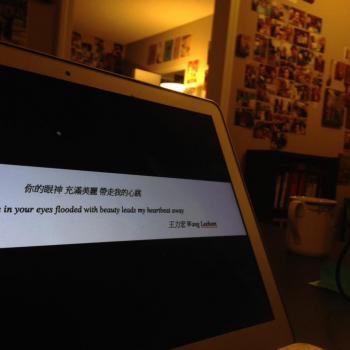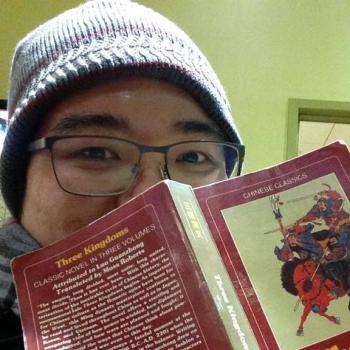I am writing this post for two reasons. The first is to begin a series of retrospective theological reflections on what happened during the Asian American evangelical open letter campaign after six months of the event and why it matters theologically more than anyone else thinks. The second is to convince you that Chinglicans can pray in solidarity with the Blessed Virgin without blinking an eye. As a Chinglican, I manage to do that simply by closing my eyes.
It has been way too long since my last post. My last two posts (here and here) focused on inviting Rick Warren to a conversation due to his Asian American faux pas last September 2013. Since that time, an open letter to the evangelical church has been issued, in large part inspired by the first Korean American woman to be ordained to the Episcopal priesthood, the Rev. Christine Lee. I do have some remaining comments about the dustup since that time, especially on how Asian American evangelicals seem confused about the word ‘schism’ and who is causing it. It has been six months since the open letter. It is time for a retrospective theological assessment.
But the doing of theology needs itself to be put into the larger ecumenical framework of how the Spirit is moving people like Archbishop Justin Welby, Pope Francis, Pope Tawadros II, and Patriarch Bartholomew into a new sort of oneness, and that in turn needs to be situated within geopolitical developments that we are all watching anxiously.
That anxiousness brings me to the Blessed Virgin.
For one reason or another, I have found it difficult to pray for the last two months. You could say that the reason I’ve had trouble in prayer is the same reason that I’ve had trouble blogging: simply put, life caught up with me. Prior to the last three months, I had a steady rhythm of daily prayer: the major offices during the day, the Angelus at noon, and the Ignatian Examen and the Rosary along with Compline before bed. But in the dustup of life itself, I felt as if I had been thrown into the secular fire. Suddenly, I became too busy to pray. I found myself mouthing the words, ‘Come, Holy Spirit, fill the hearts of your people and kindle in them the fire of your love’ as the last bulwark against not praying altogether, and I think that may have saved my life. But secularity – what Charles Taylor calls ‘the immanent frame’ – has a way of making one too busy.
And so I became too busy and secular to both write and pray.
I was shaken out of my secularity on Monday evening. I don’t know how I found the impulse to pray. All I know is that I did. As I opened up to the offices, I discovered that the prayers prepared the church to celebrate the Annunciation. The words of the daily noon-hour Angelus came back to me:
V. The angel of the Lord appeared to Mary
R. And she conceived by the power of the Holy Spirit.
Hail Mary, full of grace, the Lord is with you. Blessed are you among women, and blessed is the fruit of your womb, Jesus. Holy Mary, Mother of God, pray for us sinners now and in the hour of our death.
V. Behold the handmaid of the Lord.
R. Be it done according to your word.
Hail Mary…
V. And the Word became flesh
R. And dwelt among us.
Hail Mary…
V. Pray for us, Holy Mother of God.
R. That we may be made worthy of the promises of Christ.
Let us pray.
Pour forth, we beseech Thee, O Lord, Thy grace into our hearts, that we to whom the Incarnation of Christ Thy Son was made known by the message of an angel, may by His Passion and Cross be brought to the glory of His Resurrection, through the same Christ our Lord. Amen.
The Angelus is the prayer of the Annunciation. It identifies us, the one who prays together with the whole praying church, with the Blessed Virgin receiving the message of the angel. As Hans Urs von Balthasar puts it in his book Prayer: ‘Was not the Hail Mary first proclaimed by an angel’s lips, i.e., in the language of heaven? And as for the words uttered by Elizabeth, “filled with the Spirit,” were they not the response to her first meeting with the incarnate God?’ (p. 14-15). It is why there has been a long tradition of popes praying the Angelus with the faithful gathered in St. Peter’s Square.
You could say that prior to these last few months, the Annunciation already had taught me how to pray. But like a bolt of lightning – or perhaps by the simple appearance of the angel proclaiming that Mary, like all the prophets before her to whom the angel of the Lord had appeared, had found favour with God – I was called to pray on the eve of the Annunciation. I was reminded of who I am and what position I have in the church. I do not have a merely secular existence. I am not running a rat race. I am not to eat of the fruit of knowledge of good and evil. Simply put, as an ecclesial person, I am by default simply in prayerful solidarity with the Mother of God who says to the angel, Ecce ancilla Domini: fiat mihi secundum verbum tuum. I am the handmaid of the Lord: be it done according to your word.
I write this as a Chinglican with no intention to ‘convert’ to Roman Catholicism. I’ve said before that Roman Catholics have no monopoly on the Blessed Virgin; so has Captain Thin. I like to remind my friends who say to me, ‘Just convert already,’ that we also have a high regard for Mary in the Anglican Communion. Look no further than the Anglican-Roman Catholic International Commission’s Mary: Grace and Hope in Christ to get a feeling for how high that is.
As I hinted at the beginning of this post, the passage of six months since the Asian American open letter makes this finally a good time for theological reflection on what happened there and why it matters theologically. But I am writing about my prayerful solidarity with the Blessed Virgin before saying what hasn’t yet been theologically said about the Asian American evangelical dustup because if there’s anything worth saying, it should only be said with full consciousness of our ecclesial, prayerful existence.
That’s because the open letter was not about the open letter. We were – and still are – accused of using the open letter to advance a private interest in an American evangelical public. We were – and still are – accused of being divisive. We were – and still are – accused of failing to be Christians, for not forgiving our orientalizing brothers and sisters, for choosing to grind an axe instead of taking it to the Lord in prayer.
But seen in the context of Marian prayerfulness, the open letter was about the ecumenical movement of the Spirit. As the brilliant young theologian and historian Helen Jin Kim suggests, the open letter was a sign of visible unity in a theologically and ideologically divided church. And as geopolitical conflicts break out in Ukraine, Venezuela, Mexico, and Taiwan – among other places – the oneness that the Spirit is bringing is a sign that, as Mary later prays, ‘He has shown strength with his arm; he has scattered the proud in their conceit. He has cast down the mighty from their thrones and has lifted up the lowly. He has filled the hungry with good things and the rich he has sent away empty.’ It turns out that prayer is how solidarity is done. It turns out that my secular busyness is that which has kept me from this solidarity. It turns out that prayer is not the opium of the masses – it is the fire by which the masses prophesy against injustice and schism. It turns out that the open letter is not about the open letter, but about being just one small part in a larger work of the Spirit in calling the church to be the church in a world crippled by the hawkish posturing of secular geopolitical insecurity. It was modest; make no mistake about that. But all acts of the Spirit, whether big or small, are events for theological reflection.
Justin Cantuar is fond of saying that there is ‘no renewal of the church without the renewal of prayer and praying communities.’ He walks the walk: he has invited a Catholic ecumenical monastic community, Chemin Neuf, to live with him at Lambeth Palace, and he and Vincent Cardinal Nichols have called on Anglicans and Roman Catholics to ‘walk together’ in prayer for social action during this Lenten season.
If the open letter sought to open up an ecumenical conversation about a racial schism in American Christianity, its aims can only be fulfilled by prayer. Just as a former Archbishop of Canterbury, Michael Ramsey, was fond of saying that Anglican theology is simply ‘theology done to church bells,’ the late German Protestant theologian Helmut Thielicke told his first-year theology students in A Little Exercise for Young Theologians that there was a possibility that they might come away from seminary with a diabolical theology. Making fun of the theological novice who thinks he or she knows it all because of reading a first-year textbook on dogmatics, he says that the know-it-all attitude of a merely book-smart theologian criticizing the kitschiness of the parish church is of the devil. A theology that is from God is a kneeling theology. It is a theology derived from immersion in prayer. It is to approach the Blessed Virgin as she ‘ponders all these things in her heart’ and to ask her, ‘Mary, what are you thinking about?’ It is a prayerful posture that positions the theologian in radical solidarity with the church, however nuts he or she might be driven by the church.
Thielicke’s short book was the first book given to me when I first got my feet wet in Chinglicanism. It has never left me. A Chinglican theology – one committed to post-colonial ecumenism – must be bathed in the prayer of the church, the Blessed Virgin’s radically prayerful obedience to God: fiat mihi secundum verbum tuum. It is only then that we participate in the prayer, ‘Come, Holy Spirit, fill the hearts of your people and kindle in them the fire of your love.’
It’s with that in mind that we can finally proceed to an examination of what actually happened theologically and ecumenically six months ago among Asian American Christians. It is not passé. After all, if the Spirit has been at work over the last year toward ecumenical unity and has in his divine humour included Asian American Christians in this work, then we had better bet that the Lord has only gotten started.
—-
POSTSCRIPT: Some hasty readers may think that this post is motivated by the recent hastag #CancelColbert, in reference to Comedy Central’s satirical tweet from The Colbert Report about orientalization. While discussion about that hashtag is circulating through the blogosphere, I would seriously caution comparing the Asian American open letter to the evangelical church with these secular events. This is not to say that Colbert is secular; he is openly Catholic, though his show airs on a secular forum. While a theological reflection on his culpability in orientalizing processes may be warranted at some point, it would be categorically inappropriate to lump the two together, not least because the ecumenical implications would be obscured by such a careless move.
SECOND POSTSCRIPT (27 July 2016): I began this series of posts but never completed it. They were written for readers on the Asian American ‘evangelical left.’ Now I am Eastern Catholic, and Asian American evangelicals have moved on from this as well.















